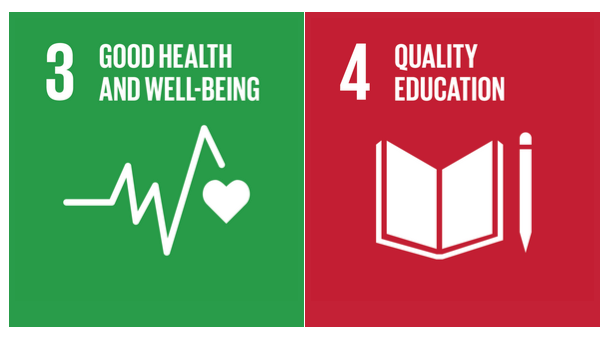
3 - Gender Equality
The Sustainable Development Goals (SDGs) set by the United Nations serve as a comprehensive roadmap for addressing global challenges. Among these goals, SDG 3 aims to ensure healthy lives and promote well-being for all at all ages.
It emphasises the importance of accessible healthcare, disease prevention, and mental well-being.
In this blog post, I will delve into the significance of SDG 3 and explore how a holistic approach can contribute to achieving good health and well-being worldwide.
Universal Health Coverage:
One of the crucial elements of SDG 3 is the concept of universal health coverage (UHC). UHC ensures that everyone, regardless of their socio-economic background, has access to essential health services without suffering financial hardship. By investing in robust healthcare systems and expanding coverage, countries can reduce health inequalities and enhance overall well-being.
Disease Prevention and Management:
Another key aspect of SDG 3 is the prevention and control of diseases. Promoting healthy lifestyles, immunisation programs, and early detection strategies play a vital role in reducing the burden of communicable and non-communicable diseases. Targeted interventions against HIV/AIDS, malaria, tuberculosis, and other infectious diseases can save millions of lives and contribute to improved health outcomes.
Maternal and Child Health:
SDG 3 places significant emphasis on maternal and child health as they are fundamental to the well-being of societies. Ensuring access to quality antenatal care, skilled birth attendants, and postnatal support is essential for reducing maternal and neonatal mortality rates. Investing in early childhood development programs and promoting adequate nutrition and education can help children thrive and reach their full potential.
Mental Health and Well-being:
Good health extends beyond physical well-being and encompasses mental health as well. Mental health conditions affect millions of individuals worldwide, often leading to profound social and economic consequences. SDG 3 emphasizes the need to promote mental health, raise awareness, and provide accessible mental healthcare services. Reducing stigma, integrating mental health into primary healthcare systems, and implementing community-based support networks are crucial steps toward achieving this goal.
Multi-sectoral Collaboration:
Addressing the complex challenges related to health and well-being requires multi-sectoral collaboration and partnerships. Governments, civil society organizations, private sectors, and academia must work together to strengthen health systems, research new treatments, and develop innovative solutions. Collaboration across sectors can enhance the impact of interventions and pave the way for sustainable improvements in health outcomes.
Top tips to help you achieve this:
Workplace Wellness Programs:
Implementing workplace wellness programs can promote the health and well-being of employees. These programs can include initiatives such as health screenings, exercise classes, mental health support, and healthy eating options. By prioritising employee well-being, businesses can enhance productivity, reduce absenteeism, and create a positive work environment.
Health Education and Awareness Campaigns:
Businesses can play a role in raising awareness about health issues by organizing educational campaigns. These campaigns can focus on topics such as preventive measures, healthy lifestyles, and mental health. Companies can host workshops, distribute informational materials, or organise health-related events to empower individuals to take control of their well-being. I always recommend updating staff notice boards on a regular basis.
Accessible Healthcare Benefits:
Providing comprehensive healthcare benefits to employees ensures they have access to quality healthcare services. Businesses can offer health insurance coverage, preventive care services, and mental health support as part of their employee benefits package. By removing barriers to healthcare, businesses contribute to the overall well-being of their workforce.
Partnerships with Healthcare Providers:
Collaborating with healthcare providers can facilitate access to healthcare services for employees. This can involve establishing partnerships with local clinics or hospitals to provide discounted services or on-site healthcare facilities. By offering convenient access to healthcare, businesses can support their employees’ health and well-being.
Innovation and Technology:
Businesses can harness the power of innovation and technology to address health challenges. Developing digital health solutions, telemedicine platforms, or mobile applications can facilitate access to healthcare services, especially in remote areas. Embracing technology-driven solutions can enhance efficiency, improve healthcare outcomes, and expand access to medical information.
Sustainable and Healthy Products:
Businesses can contribute to good health and well-being by offering sustainable and healthy products. This can involve promoting organic and locally sourced food, eco-friendly personal care products, or sustainable healthcare equipment. By prioritising sustainable and healthy choices, businesses can have a positive impact on the environment and consumer well-being.
Remember, even small actions can make a difference when it comes to achieving SDG 3. By incorporating these business solutions into their operations, companies can contribute to building healthier communities and supporting the overall well-being of individuals. Having a fresh bowl of fruit each day for staff. Maybe on a Friday buy in local produced salads? Having educational speakers visit to talk about their field.
4 - Quality Education
In today’s fast-paced world, quality education is crucial for individuals and society to thrive. It equips individuals with the necessary knowledge, skills, and opportunities to succeed in their personal and professional lives.
However, achieving quality education on a global scale requires strategic planning and effective business solutions.
In this blog post, I will explore the goals of the Sustainable Development Goal (SDG) for education (SDG 4) and discuss various business solutions that can contribute to improving the quality of education.
- Access to quality education: Ensuring that every child, regardless of their background, has access to free, equitable, and quality primary and secondary education.
- Enhancing literacy and numeracy skills: Focusing on improving literacy and numeracy rates to provide individuals with foundational skills for lifelong learning.
- Bridging gender and social gaps: Addressing gender disparities and promoting equal opportunities for education among marginalised groups.
- Promoting lifelong learning opportunities: Encouraging learning opportunities beyond formal education to foster continuous personal and professional development.
- Leveraging Business Solutions for Quality Education:
- Corporate Social Responsibility (CSR) Initiatives: Businesses can integrate education-focused CSR programs into their operations. This can involve sponsoring scholarships, providing mentorship programs, or supporting schools in underprivileged areas. By investing in education, companies contribute to the development of a skilled workforce and foster goodwill within their communities.
- Skill Development Programs: Businesses can design skill development programs in collaboration with educational institutions to bridge the gap between industry requirements and academic curricula. By offering internships, apprenticeships, and vocational training, companies prepare students for the workforce, ensuring they possess relevant skills and knowledge.
Achieving quality education for all is a shared responsibility that requires collaborative efforts from governments, businesses, and communities. By aligning their goals businesses can contribute to the advancement of quality education through innovative solutions, public-private partnerships, CSR initiatives, skill development programs, and data-driven decision making. Together, we can empower individuals with the knowledge and skills needed to shape a prosperous and sustainable future.
How to get started:
Assess Your Resources and Expertise:
Evaluate the resources, skills, and expertise within your organization that can be leveraged to support quality education. Consider the areas where you can make the most significant impact based on your strengths and available resources.
Define Your Objectives:
Clearly define your objectives and the specific areas of education you want to support. Determine whether you want to focus on a particular age group, subject area, or geographical location. This will help you establish a clear direction and make targeted efforts.
Research and Identify Partnerships:
Conduct thorough research to identify potential educational institutions, nonprofits, or community organizations that align with your objectives. Look for organizations that share your vision and have established programs or initiatives in place. Reach out to them to discuss potential partnerships and collaboration opportunities.
Establish Meaningful Partnerships:
Once you have identified potential partners, initiate conversations to establish meaningful partnerships. Discuss your objectives, resources, and how you can mutually benefit each other. Determine the scope of the collaboration, roles and responsibilities, and the desired outcomes.
Develop a Plan:
Create a detailed plan outlining the activities, initiatives, and timeline for your educational contributions. Identify specific projects, programs, or initiatives that you will undertake, along with the resources required and the expected outcomes. Ensure that your plan is realistic and aligned with your business goals.
Allocate Resources:
Allocate dedicated resources, both financial and human, to support your education initiatives. This may involve budgeting funds, allocating employee time, or providing necessary infrastructure and technology. Consider establishing a separate budget or funding mechanism to support your education-related activities.
Engage Employees:
This is a huge one for me. Encourage and involve your employees in the education initiatives. Communicate your goals, foster a culture of volunteerism, and provide opportunities for employees to contribute their skills and expertise. Consider establishing employee volunteering programs or providing incentives for participation.
Measure and Evaluate Impact:
Establish metrics and indicators to measure the impact of your education initiatives. Monitor and evaluate the progress regularly to assess the effectiveness of your programs.
Communicate and Collaborate:
Again communication – I am always banging on about this!! Share your education initiatives with your team, customers, and the wider community. Highlight the positive outcomes and the benefits of your contributions to quality education. Seek feedback and collaborate with other businesses or organisations working towards similar goals to amplify the impact.
Continuously Improve:
Maintain a commitment to continuous improvement by assessing your initiatives, learning from challenges, and refining your strategies. Stay updated on current trends and best practices in education to ensure your efforts are aligned with evolving needs and priorities.


